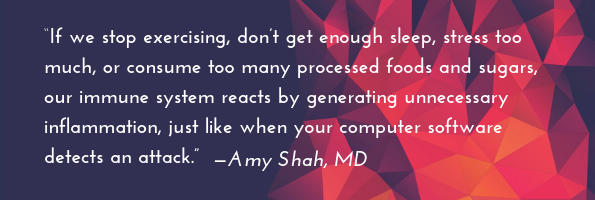
Inflammation in the body is a good thing … until it’s not. When you suffer an injury or an infection, your body’s immune system quickly dispatches healing cells straight to the source. If you sprain your ankle, for instance, you will almost instantly see and feel the symptoms of acute inflammation, which can be remembered with the acronym PRISH: pain, redness, immobility, swelling and heat.
This type of inflammation is an essential part of a healthy immune system; it signals that the body is attempting to heal itself, and any pain and immobility you experience are a warning to you to stay off your ankle and employ RICE (rest, ice, compression and elevation) techniques to ease your discomfort. When the healing process is complete, the inflammatory response normally shuts itself off.
Chronic inflammation, however, is a different story. Because you can’t see or actually feel this type of inflammation, it’s often referred to as the body’s “silent fire”—which makes perfect sense, because the word “inflammation” derives from the Latin word for “to set on fire.” Chronic inflammation occurs when the body’s immune system doesn’t shut off for some reason and begins to burn out of control, like a fire that can’t be extinguished easily. It just keeps producing immune cells, leaving your body in a constant state of alert.

When the immune cells can’t find an injury or illness to repair, they eventually attack healthy cells, damaging your tissues and organs. This sort of damage has been linked to a number of diseases and disorders, including asthma, ulcers, rheumatoid arthritis, heart disease, ulcerative colitis, allergies, some types of cancer and even Alzheimer’s.
“Unfortunately, you can’t see low-grade, chronic inflammation until the damage is already done,” says Desiree Nielsen, a registered dietitian in Vancouver, British Columbia, who focuses on complex chronic digestive and inflammatory disease. The biggest challenge is that it’s largely silent for many of us, unless you know what to look for. Chronic inflammation itself can be silent, but of course, the overt diseases aren’t. You may know when you have eczema or diabetes, but you might not realize that it has something to do with inflammation.”